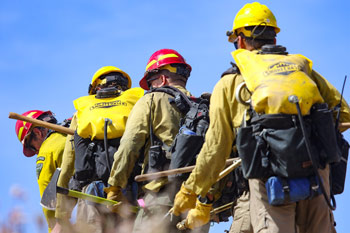Click Here for California Fires
August 8, 2024 - Currently, 93 large active wildfires are being managed with full suppression strategies nationwide. Wildfires have burned 2,400,069 acres nationwide.  About 28,179 wildland firefighters and support personnel are assigned to wildfires, including 29 complex and 3 Type 1 incident management teams, 630 crews, 1,625 engines, 172 helicopters, and six Modular Airborne Fire Fighting Systems, or MAFFS.
About 28,179 wildland firefighters and support personnel are assigned to wildfires, including 29 complex and 3 Type 1 incident management teams, 630 crews, 1,625 engines, 172 helicopters, and six Modular Airborne Fire Fighting Systems, or MAFFS.
Wildland fire managers prepare for strong winds in northern Idaho and some lightning across Idaho and eastern Oregon and into Wyoming over the next couple days.
Evacuation orders are in effect on 17 wildfires in the Northwest, Great Basin, Northern California and Southern areas. If you live in an area that has been evacuated, please follow the instructions from local authorities. They will provide the latest recommendations based on the threat to your community and appropriate safety measures. As you prepare your ‘go kit’ or create a family evacuation plan, remember these few items for your pets: water/food, medications, leashes, a photo of your pet(s), and pet carrier to keep them safe. Learn more about evacuation plans and animal evacuation tips at https://www.ready.gov/.
For more information about the mobilization of wildland firefighters from Australia and New Zealand visit the international support page.
Take a look at the fuels and fire behavior advisories issued for Colorado's Front Range and Eastern Wyoming, Southwest Oregon, the region east of the Cascades in Oregon and Washington, Nevada, Southern Idaho, Utah, and California. Residents, travelers, or workers on their way to any of these states should be advised and familiarize themselves with the elevated risks.
The current reporting from source data for year-to-date figures appears to be underreporting fire acreage in some geographic areas and, therefore, the overall national statistics. Given the very high tempo and scale of national current fire activity, there will be delays in reconciling, especially from areas with large fires and dynamic fire activity. Adjustments may occur as the accuracy of fire locations, mapping and final fire reporting is reconciled.
National Predictive Services Outlook Above normal temperatures will continue along the West Coast into the Great Basin, with the greatest anomalies forecast west of the Cascades and Sierra. Dry conditions with humidity as low as 5-20% will continue across much of the West with poor overnight recovery. Northeasterly sustained winds of 12-22 mph with gusts up to 30 mph will develop in the Columbia Basin. Easterly winds of 8-20 mph with gusts up to 40 mph will develop in the central Cascades from Mt. Jefferson to Mt. Rainier, strongest in the Columbia Gorge and Cascade gaps. Thermal troughing will also develop near the Oregon/Washington Cascades enhancing low-level instability. Farther south, breezy afternoon southwesterly sustained winds of 12-20 mph with gusts to 30 mph will develop in northeast California and southeast Oregon into northern Nevada. Scattered to widespread wet thunderstorms are likely in eastern Wyoming and east of the Divide in Colorado, with heavy rains possible on the recent burn scars on the Front Range where debris flows could occur. Scattered mainly wet thunderstorms are also likely in the Southwest, southern Great Basin, and southeast California. Hot and dry conditions will continue in much of Texas and Oklahoma. A cold front will move through the Texas Panhandle and Oklahoma in the afternoon and evening bringing north winds near 20 mph, although humidity will increase with cooling temperatures. Tropical Storm Debby will slowly move north bringing heavy rain in the eastern Carolinas into the Mid-Atlantic, with areas of flooding.
| Number of new large fires or emergency response * New fires are identified with an asterisk |
10 | States currently reporting large fires: |
| Total number of active large fires Total does not include individual fires within complexes. |
93 | |
| Acres from active fires | 2,400,069 | |
| Fires contained | 8 |
Year-to-date statistics
| 2024 (1/1/24-8/08/24) | Fires: 29,871 | Acres: 4,895,025 |
| 2023 (1/1/23-8/08/23) | Fires: 32,602 | Acres: 1,411,277 |
| 2022 (1/1/22-8/08/22) | Fires: 40,059 | Acres: 5,864,512 |
| 2021 (1/1/21-8/08/21) | Fires: 39,267 | Acres: 3,540,703 |
| 2020 (1/1/20-8/08/20) | Fires: 33,683 | Acres: 2,288,770 |
| 2019 (1/1/19-8/08/19) | Fires: 28,331 | Acres: 3,583,751 |
| 2018 (1/1/18-8/08/18) | Fires: 39,628 | Acres: 5,430,771 |
| 2017 (1/1/17-8/08/17) | Fires: 40,629 | Acres: 6,041,641 |
| 2016 (1/1/16-8/08/16) | Fires: 36,103 | Acres: 3,569,814 |
| 2015 (1/1/15-8/08/15) | Fires: 37,693 | Acres: 6,161,928 |
| 2014 (1/1/14-8/08/14) | Fires: 35,085 | Acres: 2,401,651 |
10-year average Year-to-Date
| 2014-2023 | Fires: 36,122 | Acres: 3,951,811 |
Source: NIFC








